Howard Pierce is one of the happy stories of the 1930’s and on in the pottery community. With limited formal schooling and a self-financed trip around the world, Pierce moved from Chicago to California to live with an aunt in 1934. Devoted to human and non-human anatomy and physiology, Pierce developed exceptional sketching abilities to create simple, flowing figures that helped define Mid-Century Modern (MCM) tastes, especially in California and throughout the United States. Howard Pierce was an integral part of the post-World War II sense of simplicity in design and décor, contributing to the lives and homes of a burgeoning and mobile population, especially the urban and suburban middle class.
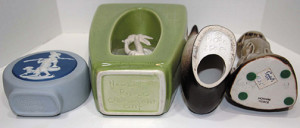 Born in the 1910’s and living through the extravagant 1920’s and the following Great Depression, Pierce entered pottery with William Manker Ceramics, becoming Production Manager within a few years. Having apprenticed under Ernest Batchelder and graduated from the Chouinard School of Art, Manker opened a studio in 1932, later relocating to Padua Hills near Claremont and a teaching position at Scripps College. Manker’s extensive work with glazes and multiple colors influenced and provided critical knowledge to young Pierce. He learned the business “OJT,” making glazes and designing and creating molds for Manker and others, including Kay Finch, another famous Manker protégé.
Born in the 1910’s and living through the extravagant 1920’s and the following Great Depression, Pierce entered pottery with William Manker Ceramics, becoming Production Manager within a few years. Having apprenticed under Ernest Batchelder and graduated from the Chouinard School of Art, Manker opened a studio in 1932, later relocating to Padua Hills near Claremont and a teaching position at Scripps College. Manker’s extensive work with glazes and multiple colors influenced and provided critical knowledge to young Pierce. He learned the business “OJT,” making glazes and designing and creating molds for Manker and others, including Kay Finch, another famous Manker protégé.
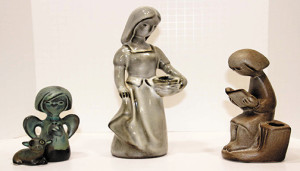 By 1941, Howard Pierce struck out on his own while employed as a World War II draftsman by Douglas Long Beach. Joined by his wife and life-long partner, trained art teacher Ellen, they made lapel pins with painted, copper, or pewter finishes. These pieces foreshadowed his post-war ceramics, and occasionally can be found in prices around and over $100. In 1945, the Pierces opened a home studio in LaVerne with a single kiln, using a base mixture potash feldspar, Florida china clay, and Kentucky/Tennessee ball clay. His satin glazes, particularly satin-matte brown on white, became hallmarks of his pieces, many with script or stamped signatures. (See photo to the right.) After personally building a new family house and studio in Claremont and with marketing through local accounts including Frankoma Pottery and Calico Ghost Town, and nationally by N.S. Gustin Company from 1950, the business grew to three gas-fired kilns. Pierce experimented for a short time with labor-intensive Wedgewood Jasperware-style planters, vases, boxes, and tea sets. Another interesting venture came with vases, planters, and bowls in high-gloss finishes with carefully made white bisque figure highlights inset into the piece. (See photo above.) With expiration of the Gustin contract in 1966, the Pierces “retired” to a more leisurely production scale with a Howard-designed house on 20 acres above the desert town of Joshua Tree. External motifs made by Pierce reflecting his desert surroundings and Northwest Native American designs graced the structure. For the next 23 years, Pierce continued to create graceful simplicity inspired by his Mojave Desert surroundings, including Gambel’s quail, rabbits, roadrunners, owls, chipmunks, squirrels, desert tortoises, and coyotes. Over the years, Howard’s “zoo” also included bears, beaver, bison, chickens, deer, dolphins, doves, ducks, frogs, elephants, (Art Deco) gazelle, geese, giraffes, gulls, hippos, koalas, mice, monkeys, mountain goats, pelicans, penguins, pigeons, porcupines, rhinos, snakes, and unicorns, as well as dogs, cats, horses, and cattle.
By 1941, Howard Pierce struck out on his own while employed as a World War II draftsman by Douglas Long Beach. Joined by his wife and life-long partner, trained art teacher Ellen, they made lapel pins with painted, copper, or pewter finishes. These pieces foreshadowed his post-war ceramics, and occasionally can be found in prices around and over $100. In 1945, the Pierces opened a home studio in LaVerne with a single kiln, using a base mixture potash feldspar, Florida china clay, and Kentucky/Tennessee ball clay. His satin glazes, particularly satin-matte brown on white, became hallmarks of his pieces, many with script or stamped signatures. (See photo to the right.) After personally building a new family house and studio in Claremont and with marketing through local accounts including Frankoma Pottery and Calico Ghost Town, and nationally by N.S. Gustin Company from 1950, the business grew to three gas-fired kilns. Pierce experimented for a short time with labor-intensive Wedgewood Jasperware-style planters, vases, boxes, and tea sets. Another interesting venture came with vases, planters, and bowls in high-gloss finishes with carefully made white bisque figure highlights inset into the piece. (See photo above.) With expiration of the Gustin contract in 1966, the Pierces “retired” to a more leisurely production scale with a Howard-designed house on 20 acres above the desert town of Joshua Tree. External motifs made by Pierce reflecting his desert surroundings and Northwest Native American designs graced the structure. For the next 23 years, Pierce continued to create graceful simplicity inspired by his Mojave Desert surroundings, including Gambel’s quail, rabbits, roadrunners, owls, chipmunks, squirrels, desert tortoises, and coyotes. Over the years, Howard’s “zoo” also included bears, beaver, bison, chickens, deer, dolphins, doves, ducks, frogs, elephants, (Art Deco) gazelle, geese, giraffes, gulls, hippos, koalas, mice, monkeys, mountain goats, pelicans, penguins, pigeons, porcupines, rhinos, snakes, and unicorns, as well as dogs, cats, horses, and cattle.
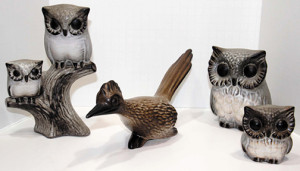 While known for his sometimes-whimsical animals, Howard Pierce made many human figurines as well. Some were exotic Polynesian or Eskimo inspired figures, but many were from Pierce’s devotion to children and animals together, as well his spirituality, including angels, monks, St. Francis, and several Madonna and Child modernist pieces. Pierce also created experimental pieces in polyurethane, larger pewter and bronze, aluminum, hydrocal, paper for Christmas cards, and plaster. Having moved to Joshua Tree, he created a variety of animals from concrete to adorn the family property; 8-foot tall “Roadrunner Pete,” a bison, 200-pound rabbits, a 150-pound raven “Edgar,” and 600-pound desert bighorn sheep Henry. With Twentynine Palms and its Marine and Army base nearby, Pierce developed a close relationship with base members, ultimately donating a 12-foot tall bald eagle to Marines in 1985 and a completing his only commissioned work 9 feet of “Howling Coyote” at the Army’s Ft. Irwin in 1989. Various Howard Pierce donated pieces decorate the Hi-Desert/Joshua Tree community, attesting to the Pierce’s sense of civic pride and service.
While known for his sometimes-whimsical animals, Howard Pierce made many human figurines as well. Some were exotic Polynesian or Eskimo inspired figures, but many were from Pierce’s devotion to children and animals together, as well his spirituality, including angels, monks, St. Francis, and several Madonna and Child modernist pieces. Pierce also created experimental pieces in polyurethane, larger pewter and bronze, aluminum, hydrocal, paper for Christmas cards, and plaster. Having moved to Joshua Tree, he created a variety of animals from concrete to adorn the family property; 8-foot tall “Roadrunner Pete,” a bison, 200-pound rabbits, a 150-pound raven “Edgar,” and 600-pound desert bighorn sheep Henry. With Twentynine Palms and its Marine and Army base nearby, Pierce developed a close relationship with base members, ultimately donating a 12-foot tall bald eagle to Marines in 1985 and a completing his only commissioned work 9 feet of “Howling Coyote” at the Army’s Ft. Irwin in 1989. Various Howard Pierce donated pieces decorate the Hi-Desert/Joshua Tree community, attesting to the Pierce’s sense of civic pride and service.
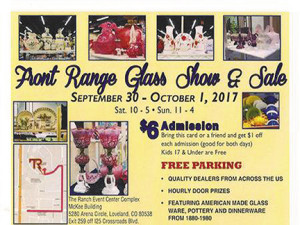 Several reasons for Pierce’s extended success were his attention to process simplification, self-reliance, and his strong comprehension of both process and market. Pieces were matured in one 2,150 degree firing and, to save time, his name was stamped. He adopted styles that didn’t embody excess detail or decoration, sketched his own designs, built his clay sculptures and the subsequent molds, developed his own spray glazes (avoiding time-consuming hand application), fired pieces only once, and performed most of the production himself.
Several reasons for Pierce’s extended success were his attention to process simplification, self-reliance, and his strong comprehension of both process and market. Pieces were matured in one 2,150 degree firing and, to save time, his name was stamped. He adopted styles that didn’t embody excess detail or decoration, sketched his own designs, built his clay sculptures and the subsequent molds, developed his own spray glazes (avoiding time-consuming hand application), fired pieces only once, and performed most of the production himself.
Howard Pierce spent his life creating treasures for people. While his designs might be considered “mass-produced,” Pierce was in many ways the embodiment of the Arts and Crafts Movement of 50-75 years earlier; skilled and hand worked craftsmanship and beauty for the home. He wasn’t in business to become rich; the Pierces always lived within their means and were never flamboyant. Pierce porcelain products were priced to sell. His partner and wife helped guide his creativity with focus on marketing. The definitive work highlighting the great breadth of Howard Pierce’s art is the Collector’s Encyclopedia of Howard Pierce Porcelain by Darlene Hurst Dommel. An insightful website is offered by his son Jerry at http://www.howardpierceceramics.com/ Howard_Pierce_Ceramics.
I again must give a shout out to the DeStefanos who promote collecting within our region via the Mountain States Collector. They perform a great service for many types of collecting hobbies. I am pleased to note Jodi and Mark Uthe continue to sponsor the Front Range Glass Show, this year September 30 and October at the Budweiser Event Center near Loveland, Colorado. I bought several Howard Pierce pieces at last year’s Front Range Glass Show, and I expect that this one will have a nice selection from the fantastic dealers Jodi and Mark have gathered.

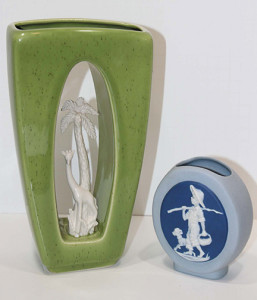














Follow Us